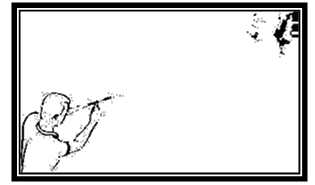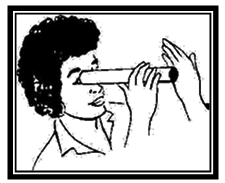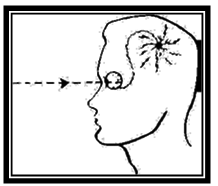Science Project on “OUR SENSES”,. Class 9 & 10 Science Project.
OUR SENSES
Roll up a piece of paper to make a long tube. Sight through the tube at an object. Place your hand alongside the tube as shown in the drawing. You see a big, clean hole right in the middle of your hand!
Why do your eyes fool you? To answer this question it will be necessary to learn something about your sense of sight.
Sight
In many ways your eye resembles a camera. Both have lenses that form images. Both have an adjustment at the front for letting in more light, or less. And both have some way of registering the image on the back. In the camera the lights and darks of the images are
registered on film. Your eye registers the image by means of numerous nerves on the retina. Each nerve is like a long electric wire with one end on the retina and the other end deep inside the brain.
When the sensitive end of a nerve on the retina is struck by light, a kind of electric current travels to a certain spot in the brain. Your brain receives thousands of such electric messages from the many nerves on the retina. Each image on the retina forms a different pattern of such electric messages. Your brain puts together the pattern to recognize the objects outside.
Now look at a window or distant scene. Hold up your finger at arm’s length. With one eye closed look at the scene just over the top of your finger.
Note the objects that you see without changing your position look at the scene with the other eye. The background shifts. You see a different object beyond your finger.
This experiment shows that a different image is observed in each eye.

This occurs because each eye is in a slightly different place. Your brain puts together the slightly different images in each eye to form a single impression of the scene. In fact, the slight differences help the brain to judge distance and solidity of objects out in front of you.
You can now see why a hole in your hand was observed when you looked through a tube. The eye that looked through the tube did not see the hand. The eye that saw the hand did not see the round end of the tube. When your brain put the two images together you saw both together at the same time. Thus the hole and the hand appeared in the same place, and you saw a “hole” in your hand.
Touch
Touch the point of a thin nail to different spots on the back of your middle finger, as shown in the drawing. You feel the pressure of the nail point wherever you touch it to the skin. But at some places you feel the point more sharply than at others. These are spots that feel pain.
Place the nail on ice for a short while. Then repeat the experiment of touching it to your skin. At some places the nail feels cold. At other places you can’t feel the cold at all. Now dip the nail into hot water for a few moments and then touch it to your skin at different places. This time certain spots feel warm, while others do not. Repeat these experiments on the back of your neck. You get similar results, but there are fewer places at which you find the skin sensitive to touch, pain, cold and warmth. The skin of your body contains thousands of nerves, each of which has a direct electric
path to a spot in the brain. The nerves go up to the brain through the spinal cord inside your backbone.
There are different kinds of nerves. Some are sensitive to touch; others cause a sensation of pain. Still others sense heat or cold. The messages that arrive in the brain from different places all over the body enable you to tell what is happening. Without such a nervous system you would not know if a sharp edge is cutting the skin of your leg, or if a finger is being burned or frozen. You would therefore be seriously handicapped in avoiding danger.
A similar system of nerves goes out from the brain to all the muscles and organs of the body. When your brain gets a message that means danger other messages are sent out to the muscles to tell them to move and get you away from the danger. You either pull away your body or use your legs to run away.
Hearing
Make different sounds behind a person’s back. Click spoons together. Drop a coin. Scrape a nail on wood. Even though the person cannot see what is happening he can tell that something is moving, and he can often tell what is causing the sound. He can tell these things because of his remarkable sense of hearing.
Whenever two objects are struck against each other they vibrate rapidly. The air around the objects is set into similar vibration. A sound wave then travels away from the objects through the air. The wave enters your ear and moves into a narrow canal to your eardrum.
shown in the drawing. The eardrum, vibrates. A set of bones are then set into vibration. The vibration finally reaches a coiled-up organ, the inner ear, which contains thousands of tiny nerve endings. Different kinds of sounds cause different patterns of electric current in these nerves. These currents race up to the brain, which then recognizes the kind of sound you hear.
Close one ear with your finger. Ask a friend to click two spoons together anywhere behind you. Try to guess how far away the spoons are and in what direction from you. As your friend moves around you will find it very difficult to tell where he is and how far away.
You judge the distance of an object that makes a sound, and its direction, from its loudness and also from the slight differences in the sounds that reach both ears. The sound arrives a tiny bit sooner at the ear nearer to the sound. In addition, the sound in the closer ear is louder. As a result the patterns of electric current sent to your brain from each ear are slightly different. Your brain can judge distance and direction from these slight differences in the electric patterns.
A bat has such highly developed hearing that it can judge from the reflections of its squeaks what obstacles are in the way. It actually catches insects in midair in the dark by using its keen sense of hearing.
Smell
Place a small amount of perfume in a dish and walk to the opposite end of the room. After a short while you begin to smell the perfume, even though it is far from the dish. Look at the dish. The perfume is gone. It has evaporated into the air.
Everything is made of tiny particles called molecules. These molecules are always in motion, jiggling back and forth or moving around. Many of the faster molecules of a liquid shoot out into the air and leave the dish. This is what causes evaporation of a liquid such as perfume.
These molecules then bounce around in the air and gradually spread out. Some of them enter your nostrils and affect little nerves, which then send electric messages to the brain. Each substance causes a different pattern of electric messages which tells you what the substance is, or the kind of smell It is producing.
Dogs and many other animals have a sense of smell that is much keener than that of human beings As a result they are able to recognize individual people arid animals just by smell alone A bloodhound can find a person ply by following the odor hours after a person has walked by.
Taste
Blindfold a friend and feed him a piece of juicy steak while he holds his nose. Ask him what he is eating.
He is likely to think he is eating paper or string beans, rather than delicious steak
A large part of the flavor of a steak or other tasty food comes from its effect on the sense of smell. If the sense of smell is poor, or if the aroma of a food is prevented from reaching the nose, then wonderfully flavored foods seem to be very ordinary, or even tasteless.
Another part of the taste of a food is due to taste buds on the tongue. Dissolve a spoonful of sugar In a quarter glass of water. Dip a toothpick into the sugar solution. Touch it to different parts of the tongue. You find that sweetness is detected by means of taste buds mainly at the tip of the tongue.
Try the same experiment with a sour material like vinegar. You will find this taste detected mainly at the sides of the tongue.
Try a salt solution. The sense of saltiness will be detected mainly at the tip and sides of the tongue.Try the same experiment with a bitter material, such as a bit of onion. First soak the onion in a small amount of water. You will find that the back of the tongue is most sensitive to such bitter tastes.There are other senses in addition to those of sight, touch, pain, heat, cold, hearing, smell and taste. For example there is the sense of balance. We also have a kinesthetic sense in which we are aware of the movement of our muscles and limbs. This sense enables us to tell what the parts of our body are doing at any moment.
The brain puts together the many electric currents arriving from all of our sense organs and thereby gets a picture of what is happening outside and inside of us. This is what makes it possible for us to move about freely, walk or run, drive a car or operate machinery. You can see how important these senses are to our welfare.
TRY THESE EXPERIMENTS
Seat a blindfolded person in a rocking chair. Tilt the chair back a bit. The person can usually tell his position. The position of a liquid in his inner ears enables him to tell his position, even though blindfolded.
Analyze the taste in foods. First give it to a blindfolded person who holds his nose. Then touch the food to different parts of the tongue. What part of the taste comes from the aroma? What part is due to the fact that it is sweet, salty, sour or bitter?
Blindfold a person and have him feel different surfaces. In each case ask him to state what the material is and whether he likes the feel or not. Find out whether people differ in their ability to identify materials by touch and what surfaces they like to touch.
Look in the mirror in a dimly lit room at night and note the size of the pupil, the black central spot of the eye. Turn on a very bright light in the room. The pupil closes to keep out an excess of light that might harm the nerves on the retina. Note that it takes a much longer time to return to the original size in the dimly lit room.
Certain records are sold In which sounds of different pitch are heard. As the pitch rises a point is reached where some people will hear the sound and others won’t. Younger people can usually hear higher pitched sounds than older folks.
Look at the magician below, using the right eye, with the paper held about 20 inches away. Slowly bring the paper closer while observing the drawing of the young lady in the corner of your eye. At a certain distance the young lady disappears. With closer approach she reappears. She disappears when her image on your eye falls on the blind spot, a region where all the nerves on the retina come together and go up to the brain through the large bundle called the optic nerve.
SCIENCE PROJECT
Suppose that a man is driving a car and suddenly sees an animal dash across the road in front of him. Does he step on the brake immediately; or does it take some time for him to respond?
Try this. Hold a ruler at the tip so that it hangs straight down. Ask a friend to put his finger near the bot- tom of the ruler, ready to grasp it. But not touching it. Tell him to grasp the ruler with his fingers when you let it drop. Drop the ruler. How far does it fall before your friend stops it?
You can tell how much time It took for him to respond by measuring the distance it dropped. Then find the time from this list:




































Nice Information keep up the good work